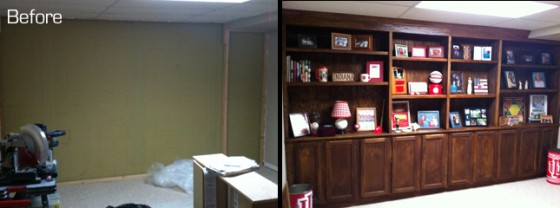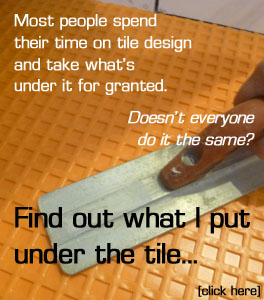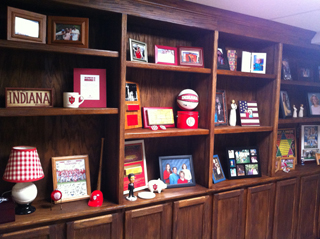 I mostly do projects involving bathrooms and tile, but recently I got to branch out and create some built-in shelving for some clients in Spencer, Indiana. They wanted to transform the end of their basement, and I’d say that we did!
I mostly do projects involving bathrooms and tile, but recently I got to branch out and create some built-in shelving for some clients in Spencer, Indiana. They wanted to transform the end of their basement, and I’d say that we did!
Much of this project took place in my work shop, which itself is a work in progress. The clients bought some stock oak wall cabinets that would serve as the base cabinets for this project. My job was to design all the shelving and supports for the walls above and put it all together nicely. The design included four banks of shelves, all of which are adjustable and removable.
I was able to make all the pieces ahead of time in the shop and assemble it on site. The supports and shelves are all made from 3/4″ oak veneer plywood, which will stain nicely and be quite strong, but is much less expensive than using solid oak. Most of the solid oak that I used was for the trim pieces that formed the face frame of the built-ins and covered all the edges of the plywood supports.
I started by framing a simple wall that was a couple feet out from the exterior cinder block wall. This created some extra storage space that the homeowners can access from an adjacent room. Instead of a normal wall with studs 16″ or 24″ on center, the wall was created to support the cabinets. I placed a stud wherever cabinets met. After installing the base cabinets along the bottom I installed 1/2″ oak veneer plywood across the top, placing all the joints so they’d be covered by the vertical shelf supports. This would be the back of the built-in shelving.

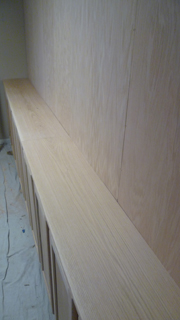 The shelf that sat atop the bottom cabinets (left) was made out of solid oak that came from a single long piece of oak that I bought from a sawyer (person who cuts wood with a sawmill). It was cut in the middle to make it easier to work with, but when I installed it, I was able to match the grain up and hide the seam beneath the middle shelf support.
The shelf that sat atop the bottom cabinets (left) was made out of solid oak that came from a single long piece of oak that I bought from a sawyer (person who cuts wood with a sawmill). It was cut in the middle to make it easier to work with, but when I installed it, I was able to match the grain up and hide the seam beneath the middle shelf support.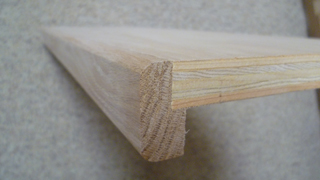
I made all the shelves (above) in the shop using 3/4″ oak veneer plywood with a strip of solid oak across the front. The piece across the front adds some thickness to the shelves, which looks nice, but it also adds quite a bit of strength to keep the shelves from sagging over time. They are joined together with a glued rabbet joint making it seamless and strong.
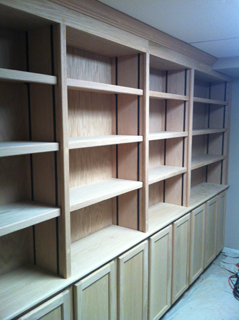 As in many basements, the ceiling has a soffit for an air duct on the far right side. I kept the shelving just below this and added a piece of oak crown at the top. I used metal shelf standards and metal clips to support the shelves. I got these in dark brown from Woodworker’s Supply (www.woodworker.com) They were great and fit perfectly into the vertical mortise I made in each support. Blended right in after everything was stained.
As in many basements, the ceiling has a soffit for an air duct on the far right side. I kept the shelving just below this and added a piece of oak crown at the top. I used metal shelf standards and metal clips to support the shelves. I got these in dark brown from Woodworker’s Supply (www.woodworker.com) They were great and fit perfectly into the vertical mortise I made in each support. Blended right in after everything was stained.
If you couldn’t tell, these clients were huge IU fans! I had a great time on this project and I’m looking forward to more woodworking projects in the future.

